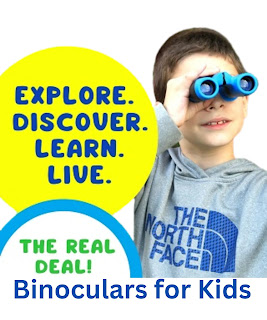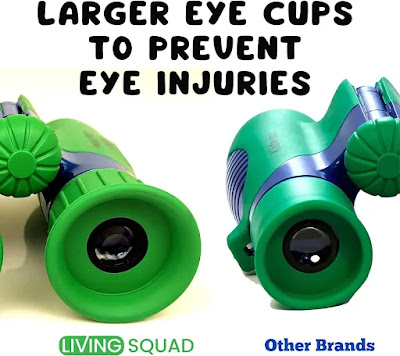Binoculars for
kids are not just toys; they are powerful tools that can ignite a lifelong
passion for nature, exploration, and learning. In this comprehensive guide, we
will delve into the world of kid-friendly binoculars, helping you choose the
perfect pair for your young adventurer.
I. Why Binoculars for Kids Matter
a. Encouraging Curiosity and Learning
Binoculars are
powerful tools for nurturing a child's innate curiosity. They allow kids to
explore their surroundings in detail, from observing birds and wildlife to
studying the night sky. By providing children with binoculars, we encourage
them to ask questions, make observations, and learn about the world around
them.
See also:
|
|
|
|
|
|
b. Connecting with Nature
In an age of
screens and gadgets, it is crucial to help kids connect with the natural world.
Binoculars provide an excellent avenue for this connection. They enable
children to appreciate the beauty of nature, whether it is the vibrant plumage
of a bird or the intricate details of a butterfly's wings.
c. Fostering Outdoor Activities
Binoculars can
be a catalyst for outdoor adventures. They motivate kids to step outside,
explore parks, forests, and nature reserves, and engage in physical activities.
As children discover the joys of birdwatching or wildlife observation, they
develop a deeper appreciation for the outdoors.
II. Key Features to Consider When Buying Binoculars for Kids
a. Durability and Build Quality
Kids can be
rough with their belongings, so it is essential to choose binoculars that can
withstand some wear and tear. Look for models with sturdy construction,
shock-resistant features, and a robust exterior.
b. Magnification and Objective Lens Diameter
Two numbers,
such as 8x32, classify binoculars. The first number represents magnification power,
while the second number indicates the diameter of the objective lens in
millimeters. For kids, consider binoculars with lower magnification (e.g., 6x
or 8x) for a steadier view.
c. Size and Weight
Kids' hands
are smaller, so opt for compact and lightweight binoculars that are easy for
them to hold and carry. Bulky binoculars may lead to fatigue and less enjoyment
during prolonged use.
d. Field of View
A wide field
of view allows kids to locate and follow subjects more easily. Binoculars with
a wider field of view make it simpler for children to track birds in flight or
wildlife on the move.
e. Ease of Use
Choose
binoculars with simple focusing mechanisms and a user-friendly design. Kids
should be able to adjust their focus and use the binoculars independently.
f. Safety Features
Ensure that
the binoculars you choose have non-toxic materials and do not pose any choking
hazards. Some models come with rubberized armor for added protection.
g. Price Range
Binoculars for
kids come in a range of prices. While it is tempting to opt for budget options,
investing in a higher-quality pair can lead to a more enjoyable and lasting
experience.
III. Top Picks: The Best Binoculars for Kids
A. Binoculars for Young Explorers (Ages 3-6)
1. Fisher-Price Kid-Tough Binoculars
- Magnification: 2x
- Objective Lens Diameter: 28mm
- Durability: Built to withstand drops and rough handling.
- Additional Features: Easy-to-use focus knob and a breakaway neck strap for safety.
The
Fisher-Price Kid-Tough Binoculars are designed with the youngest explorers in
mind. They offer a low magnification level and are extremely durable, making
them perfect for kids aged 3 to 6.
2. Educational Insights GeoSafari Jr. Kidnoculars
- Magnification: 2x
- Objective Lens Diameter: 30mm
- Durability: Sturdy construction with a focus-free design.
- Additional Features: Large eyepieces for comfortable viewing and a neck strap.
These
binoculars are specifically designed for little hands and eyes. The focus-free
feature means no frustrating adjustments for young children, and the colorful
design adds to the fun.
B. Binoculars for Adventurous Tweens (Ages 7-12)
1. Bushnell Falcon 10x50 Wide Angle Binoculars
- Magnification: 10x
- Objective Lens Diameter: 50mm
- Durability: Rubber armor coating for shock resistance.
- Additional Features: InstaFocus system for quick and easy focusing, fold-down eyecups.
The Bushnell
Falcon binoculars offer more magnification and a larger objective lens, making
them suitable for older kids. The InstaFocus system ensures rapid adjustments,
and the wide-angle view enhances the viewing experience.
2. Celestron UpClose G2 8x21 Roof Binoculars
- Magnification: 8x
- Objective Lens Diameter: 21mm
- Durability: Rubber-covered aluminum body.
- Additional Features: Lightweight and portable design, ergonomic thumb indents.
These compact
binoculars from Celestron are a great choice for tweens. They offer a good
balance of magnification and portability, making them suitable for various
outdoor activities.
C. Binoculars for Teenage Nature Enthusiasts (Ages 13+)
1. Nikon Aculon A211 10x50 Binoculars
- Magnification: 10x
- Objective Lens Diameter: 50mm
- Durability: Rubber-armored coating for shock resistance.
- Additional Features: Multicoated lenses for bright and clear images, tripod adaptable.
The Nikon
Aculon A211 binoculars provide higher magnification and superior optics, making
them ideal for older kids and teenagers interested in more advanced wildlife
observation and stargazing.
2. Vortex Optics Diamondback 8x42 Binoculars
- Magnification: 8x
- Objective Lens Diameter: 42mm
- Durability: Rubber armor, waterproof, and fog-proof design.
- Additional Features: High-quality optics with dielectric coating, lifetime warranty.
The Vortex
Diamondback binoculars offer exceptional optical performance and durability.
They are a great choice for older kids and teenagers who are serious about
outdoor exploration.
IV. How to Teach Kids to Use Binoculars Safely and Effectively
A. Proper Handling and Care
- Show kids how to hold binoculars
steadily with both hands.
- Instruct them not to touch or wipe
the lenses with their fingers.
- Teach them to use the lens covers
when binoculars are not in use to protect the lenses from dust and
scratches.
B. Focusing Techniques
- Explain the focusing mechanism,
whether it is a center focus wheel or individual eyepiece adjustments.
- Practice focusing on objects at
varying distances to help kids become proficient at getting a clear view.
C. Identifying Common Birds and Wildlife
- Encourage kids to keep a nature
journal and record their observations.
- Provide field guides or use mobile
apps to help identify birds and animals they encounter.
V. Fun Outdoor Activities for Kids with Binoculars
A. Birdwatching
- Create a bird feeder in your
backyard to attract local bird species.
- Go on birdwatching hikes in nearby
parks or nature reserves.
B. Nature Scavenger Hunts
- Develop scavenger hunt lists with
items like "find a squirrel" or "spot a red flower."
- Use binoculars to search for items on
the list.
C. Stargazing
- Explore the night sky and try to
identify constellations and planets.
- Consider a telescope for more
advanced stargazing.
D. Sports and Events
- Take binoculars to sports events,
concerts, or airshows to enhance the viewing experience.
- Get kids involved in tracking the
action.
VI. Frequently Asked Questions (FAQs)
Q. Are toy
binoculars suitable for kids?
Toy binoculars
can be fun for imaginative play but often lack the optics for meaningful
exploration. Consider kid-friendly binoculars designed for real outdoor
adventures.
Q. Can kids
use adult binoculars?
While kids can
use adult binoculars, they may find them too heavy or challenging to focus on.
It is generally better to start with binoculars designed for children and
gradually introduce more advanced models as they grow.
Q. How can I
clean and maintain my child's binoculars?
Use a soft
brush or compressed air to remove dust and debris from the lenses. Clean lenses
with a lens cleaning solution and a microfiber cloth. Store binoculars in a
protective case when not in use to prevent damage.
VII. Conclusion
Binoculars for
kids are powerful tools that can spark a lifelong love for nature and
exploration. By choosing the right pair of binoculars and teaching children how
to use them effectively, we can nurture their curiosity and connect them with
the wonders of the world around them. Whether they are observing birds,
exploring the night sky, or embarking on outdoor adventures, binoculars can
open up a world of discovery for young explorers. So, equip your child with the
perfect pair of binoculars and watch them embark on a journey of curiosity,
learning, and outdoor fun. Happy exploring!




